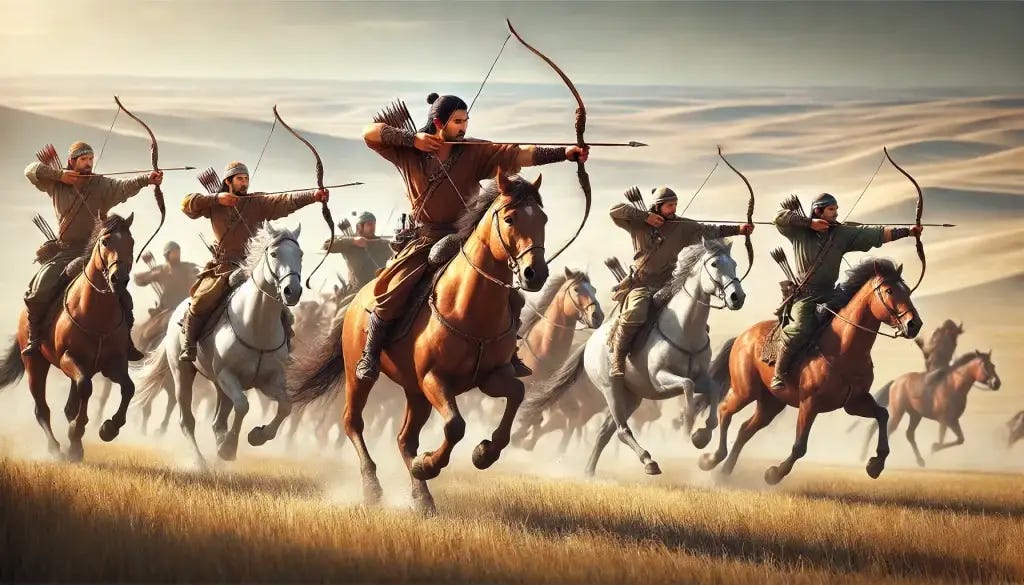The Ascendancy of Zhao: Assessing the State's Power Following its Military Reforms(Warring States 31)
The Reform and Rise of the State Zhao 5
Previous Chapter :How Was China’s First Elite Cavalry Force Created?(Warring States 30)
The strategic vision of “Adopting Nomadic Attire and Cavalry Archery胡服骑射” in State of Zhao赵 was finally implemented. The northern and southern factions sat down together, and the unified Zhao state began to mobilize its national machinery. A series of top-down changes brought by this policy started to take root and spread throughout Zhao.
The implementation of “Nomadic Attire and Cavalry Archery” first brought about a major reform in the military system.
Zhao Yong赵雍, the King of Zhao, used his own elite cavalry as a training corps to cultivate cavalry officers.
Existing infantry and infantry commanders who wished to transition to the cavalry had to undergo rigorous training and examinations. At the same time, Zhao Yong also recruited a large number of Hu allies to strengthen the cavalry ranks.
Regardless of ethnicity, without discrimination—“As long as they embrace Zhao’s way of life and political ideals, all who come are good boys.”
The state accorded cavalrymen treatment approaching that of nobility. As a result, the cavalry, serving as Zhao’s special forces and officer corps, became a privileged military class within the state.
Following the military reforms, most of Zhao’s military commanders were either drawn from the cavalry or had at least served in cavalry units. From then on, an unwritten rule was established in Zhao: “One cannot become a general without cavalry experience.”
Due to the high status and excellent career prospects associated with the cavalry, families across Zhao hoped to have a son become a cavalryman, who might eventually rise to become a cavalry commander.
Consequently, horse breeding became widely popular among the Zhao people.
Mounted archery also became a valued skill—a merit-based specialty—and an important subject for private advanced training classes among the populace.
Regarding the selection of officers, Zhao Yong personally oversaw the process. By controlling the appointment of cavalry officers, this newly established cavalry force, unlike previous mercenary cavalry units, was firmly under his direct command.
Taking advantage of the cavalry’s formation and the officer selection process, Zhao Yong also conducted a comprehensive, top-to-bottom overhaul of Zhao’s infantry system. He personally selected infantry commanders, strictly adhering to the principle of appointing based on ability.
Through these military reforms, Zhao Yong reclaimed authority over personnel appointments.
Consequently, many capable individuals from among the populace were appointed to positions. By restructuring and reforming the military system, Zhao Yong securely gained control over Zhao’s military power. Meanwhile, a large number of Zhao’s aristocratic nobles were removed from their posts, significantly weakening the influence of the southern faction. As a result, objective resistance to the military reforms gradually diminished.
The reforms extended to every corner of society. To support the specialized cavalry branch, a horse registry was established across Zhao to better manage and mobilize the nation’s potential for mounted warfare.
Zhao Yong also ordered a comprehensive census of the population, as well as large livestock such as cattle and horses, creating a reliable management system. Through this census and statistical effort, the previously concealed populations held by aristocratic clans and landowners were uncovered, thereby expanding the state’s tax base and labor resources.
The southern faction, represented by Zhao’s traditional aristocratic nobility, was dealt another heavy blow. The military merit system promoted by Zhao Yong became the primary path for both soldiers and civilians to seek wealth and status.



